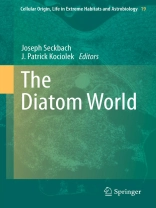Diatom biology, genomics and ecology are becoming more relevant to the human species. While there have been recent compilations of some of the applied aspects of diatoms, and the dizzying pace of taxonomic revisions, this new volume bring us up to date on their classification, biology and ecology, as well as covering the topics of genomics and applied uses. In this collection, some of the leaders in diatom research present either new information or summarize recent research efforts on a wide range of topics, including the tree of life of diatoms, their classifications, the wide habitats and ecological spectra the group exploits, as well as the beauty of their form. This volume celebrates the diversity, emerging areas of research and fascinating ecology of the diatoms bringing this group of world-renown and emerging research leaders together. ‘The Diatom World’ will foster greater appreciation and research contributions on this incredibly diverse and fascinating group of organisms.
Inhoudsopgave
Foreword; – Opening.- Collecting, Cleaning, Mounting and Photographing Diatoms.- PART 1: TAXONOMY, SYSTEMATICS AND PHYLOGENY.- Morphology: Cell Wall, Cytology, Ultrastructural And Morphogenetic Studies.- An Overview Of Diatom Classification With Some Prospects For The Future.- A Review of the Evolution of The Diatoms From the Origin of the Lineage to Their Populations.- Status of the Pursuit of the Diatom Phylogeny: Are Traditional Views and New Molecular Paradigms Really that Different?.- PART 2: DIATOM BIOLOGY.- Size and Sex.- Classical Breeding in Diatoms: Scientific Background And Practical Perspectives.- Epizoic And Epiphytic Diatoms.-Diatom Viruses.- Diatom Biofilms.- Possible Buckling Phenomena In Diatom Morphogenisis.- Diatom Frustules: Physical, Optical, and Biotechnological Applications.- PART 3: FRESHWATER ECOLOGY.- Importance of Scale in Understanding the Natural History Of Diatom Communities.- Patterns of Diatom Distribution In Relation to Salinity.- Diatoms From Hot Springs From Kuril And Sakhalin Islands (Far East, Russia).- Living On the p H Edge: Diatom Assemblages of Low p H Lakes In Western Pomerania (NW Poland).- The Diatom Algae of Lake Kinneret, Israel.- Rheophile Apennine Diatoms and Their Use as Bioindicators Of Water Quality.- PART 4: MARINE ECOLOGY.- Ecophysiological Performance of Benthic Diatoms from Arctic Waters.- Diatoms as Endosymbionts.- Marine Planktonic Diatoms, Including Potentially Toxic Species.- Toxic Diatom Pseudo-Nitzschia And Its Primary Consumers (Vectors).- PART 5: SUMMARY.- Summary.-












